
Features
Aggregates
Profiles
DJL meets urban challenge
Quebec quarry’s advanced operational methods are minimizing its impact on the surrounding community
June 10, 2010 By Andy Bateman
Based in Boucherville, Que., Construction DJL Inc. is a prominent name in the province’s infrastructure industry.
Based in Boucherville, Que., Construction DJL Inc. is a prominent name in the province’s infrastructure industry. In addition to general contracting, the company’s wide range of services includes special road products and technologies, together with aggregate and hot-mix asphalt supply from an extensive network of operations. At the St-Bruno quarry near Montreal, the company’s policy of “deploying innovative and highly efficient practices” is delivering both operational efficiency to DJL as aggregate producer and environmental benefits to its neighbours.
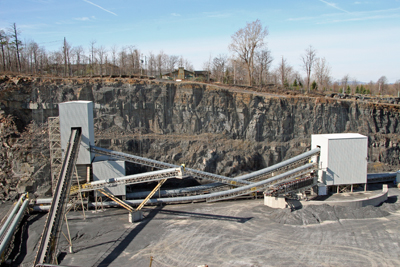 |
|
| 2006 saw the commissioning of a new secondary-tertiary crushing and screening plant at the St-Bruno quarry. The plant is located on the west side of the quarry to maximise its distance from nearby residents and the entire process is fully enclosed to minimize noise and fugitive dust. |
Just some of the advanced practices implemented to date include detailed drilling and blasting procedures, a truckless primary crushing system and enclosed secondary-tertiary plant.
Gérant (manager) Norman Scully explains that the St-Bruno site began life as a sand pit in the late 1950s. Over the years, it has developed into a substantial quarry operation to extract hornfels, the metamorphic rock outcropping here, as a source of high-quality aggregates for Montreal’s south shore market. As the quarry increased in size and scale, however, so did the surrounding community. Today’s close neighbours include the developed communities of Sainte-Julie and Saint-Bruno-De-Montarville, as well as the Parc National du Mont-St-Bruno and Mont-St-Bruno ski centre. The quarry’s closest residential neighbours in a Sainte-Julie subdivision are only about 100 m to the east, while a local school is some 450 m from a typical blast location.
Minimizing quarry impacts on neighbours is one of the key considerations in operational planning, says Scully: “In 2001, the entire primary crushing system was changed, while 2006 saw the commissioning of an enclosed secondary-tertiary crushing and screening plant. The secondary-tertiary plant is located on the west side of the quarry to maximize its distance from Sainte-Julie. A long overhead conveyor connects that plant to the existing shaping plant where aggregates for the quarry-based asphalt plant are still being produced.”
Aggregate production
The quarry currently has seven benches, with the upper three under rehabilitation and the bottom bench active. As the extraction area is close to its boundaries on all sides, long term future extraction will be from an estimated five further benches of reserves below the existing quarry floor. Current annual production is about one million tonnes.
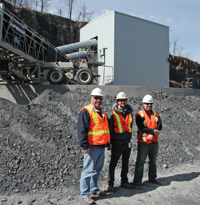 |
|
| (L to R) Martin Bouvier, Chargé de projets DJL Technologies; Félix Locas Responsable des communications Construction DJL Inc; Norman Scully Gérant d’exploitation Construction DJL Inc.
|
|
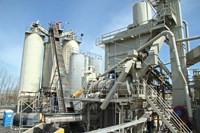 |
|
| The quarry based hot mix asphalt plant at St-Bruno combines operational efficiency with reduced environmental impact.
|
|
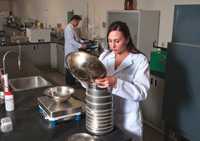 |
|
| The North American Technical Centre (CTNA), located in Brossard, south of Montreal, is North America’s central laboratory for both Eurovia and its Canadian subsidiary, Construction DJL. The Technical Centre supervises the formulation and quality control of hot mixes, cold processes (on-site retreading, cold-poured asphalting), bitumen, asphalt emulsions and granulates. The CTNA, the only centre of its kind operated by private interests in Canada, is also a training centre for technical personnel and welcomes graduate students within the framework of an international exchange program.
|
|
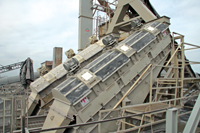 |
|
| At DJL’s St-Philippe quarry, two Tyler H – Class screens provide effective dry separation of crushed limestone fines at 1 mm, thereby avoiding the extra equipment, pumps and ponds that are an inevitable part of a wet process. (The H – Class system is one of Tyler’s fine screening systems and was formerly known as Hummer).
|
|
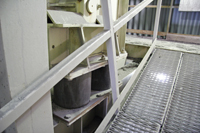 |
|
| The rubber screen mounts on this Metso 8 by 20 double deck screen are just one of multiple noise reduction measures at DJL’s St-Bruno quarry.
|
Scully explains that the primary dump hopper and crusher were previously located in an elevated location in the
centre of the quarry and, as a result, the noise generated by haul trucks and the primary itself could be heard well outside the property boundary. To address this issue, DJL replaced the primary crushing set up with a Metso Lokotrack and Lokolink truckless system operating on the quarry floor. By eliminating primary haul trucks and crushing at a much lower elevation, this change alone has reduced noise levels at receptors.
As it happened, Aggregates & Roadbuilding’s visit coincided with the first 2010 production of the 1,000 tonnes-h capacity Metso LT140 track-mounted 48 by 55 primary jaw crusher, as well as the first operating hours of the quarry’s new Caterpillar 385 C feed excavator. To reduce dust generation, the muck pile was sprayed with water before the LT140 began reducing the 600-mm minus shot rock to 150-mm minus. A pedestal-mounted BTI breaker on the primary reduced oversize as necessary. Downstream of the crusher, two integral Lokolink conveyors moved with the primary crusher, with the second conveyor discharging into a travelling transfer point mounted on rails over a field conveyor. From there, material was conveyed to a primary surge pile with a live capacity of some 10,000 tonnes. Primary crusher run was recovered from the surge pile by two reclaim feeders and conveyed to the secondary-tertiary plant. In between the surge pile and the secondary-tertiary plant, a separate side feed system with two 100-tonne capacity bins allowed 5 mm by zero screenings to be added to the material flow as required to meet granular base specifications.
Crusher run arriving at the secondary-tertiary plant entered the first of two enclosed buildings where it passed over a Metso 8 by 24 scalping screen fitted with Herma Tech rubber media. Oversize from the scalping screen was directed to a Metso HP 500 cone crusher which reduced the material to 65-mm minus. This crusher run was combined with material passing through the scalping screen and conveyed to the second enclosed building of the secondary-tertiary plant. Here, a matched pair of Metso 8 by 20 double deck screens were fitted with 65 mm and 25-mm opening screen cloths on their upper and lower decks respectively. Material retained on their upper decks was conveyed back to the HP 500 for further reduction, while material passing their lower decks was stockpiled as 25 mm minus granular road base. Meanwhile, material retained on their lower decks was directed to the shaping plant where Metso HP 300 and Sandvik H4000 crushers were utilized to make asphalt aggregates. When required, granular base materials were sized and stockpiled by the secondary-tertiary plant. A Superior TeleStacker adjacent to the first building stockpiled 65 mm minus while 19 mm minus granular base was conveyed to a second Superior TeleStacker located near the north end of the property.
Scully points out some of the features of this set up: “We find that the use of an excavator to feed the primary crusher facilitates steady material flow through the primary system compared to the large material pulses of a wheel loader. The portability of the LT140 is also important, as it can be kept close to the face and will often be moved two or three times a day. Downstream of the Lokolink conveyors, both the field conveyor and the rails carrying the transfer point can easily be extended as the primary crusher follows the active face. At the secondary-tertiary plant, we have enclosed the entire process to minimize noise and fugitive dust. Within the plant, we have also used rubber screen media and rubber mounts for the screens wherever possible to provide further noise reduction.”
Good operational practice is also in evidence at St-Bruno when it comes to product stockpiling. The two programmable Superior Telestackers produce 270-degree stockpiles, with product inventory further increased by mounting the stackers’ travel wheels on elevated concrete walls. The walls have the added advantage of providing a clean level travel surface, unlike the normal situation where the wheels may be travelling on the uneven surface of a quarry floor or in standing water.
Drilling and blasting
The drilling and blasting process at St-Bruno demonstrates perhaps better than anything DJL’s rigorous approach, with all aspects of the process completed in accordance with a detailed site-specific operating manual.
Before each blast, the face is laser surveyed to obtain an accurate face profile and this information, together with a proposed blast design, is input by consultant SNC Lavalin into a computer program to simulate air blast and vibration. Once the blast design has been finalized, subcontractor Castonguay G.P. drills the blast pattern in strict accordance with the design. A comprehensive record of each blast includes the drilling record for each hole, the selected blast pattern, explosives used, seismograph and geophone results as well as weather conditions.
With a typical blast size of 25,000 to 30,000 tonnes, three seismographs are used to cover the whole peripheral area of the quarry. Dyno Nobel’s electronic initiation system DigiShot is used to initiate the blast charge of high-density or low-density explosives and bulk ANFO. To monitor blast effects, DJL has set its own ground vibration level (Peak Particle Velocity, or PPV), at an extremely low level compared to the provincial specification of 40 mm / second. Geophones on the seismographs record air blast at receptors. Here again, DJL has set its own target level to minimize effects on the neighbourhood, although there is no provincial specification for air blast. Last but not least, noise reduction measures include an earth barrier wall, constructed on the east side of the property from 1990 to 2005.
Scully adds that there are two blast time windows of 11:45 a.m. or 1:45 p.m., with the timing of each blast based on wind speed, wind direction and cloud cover. Flags and wind socks at multiple locations help to determine the optimum blast time. Once the time has been decided, a fax is sent to the school and ski centre two hours before each blast, followed in each case by a confirmation fax sent one hour before the blast.
Sometimes, even all these measures are not enough to satisfy the company’s approach to its neighbours. “We have been known to run out of shot rock rather than blast in unsuitable conditions”, says Scully. “As one might expect, we avoid that situation if at all possible by maintaining sufficient raw material inventory.”
Hot-mix asphalt plant
The quarry based hot-mix asphalt plant at St-Bruno is a combination drum batch plant design which, together with 650 tonnes of product storage in three silos, allows both small-batch customers and high-volume continuous contracts to be supplied. Here again, DJL has combined increased operational efficiency with reduced environmental impact. At the feed end of the process, fine aggregates (5 mm by 0) are covered to reduce fugitive dust generation, but, as these finer materials tend to retain moisture from precipitation, covered stockpiles also mean less energy consumed in drying the feed. Cold feed is dried and heated in the new Industries Samson insulated dryer fired by a CBS burner. The dryer incorporates a novel flight design and in-house technology to improve drying efficiency. Additional environmental mitigation measures at the plant include extensive ductwork to provide fume recovery and dust recovery, while the baghouse stack has been raised by an additional 4.6 m to help dissipate any residual plant odour and water vapour.
Construction DJL Inc. is the Canadian subsidiary of the Eurovia Group, itself part of the worldwide Vinci group.
Print this page